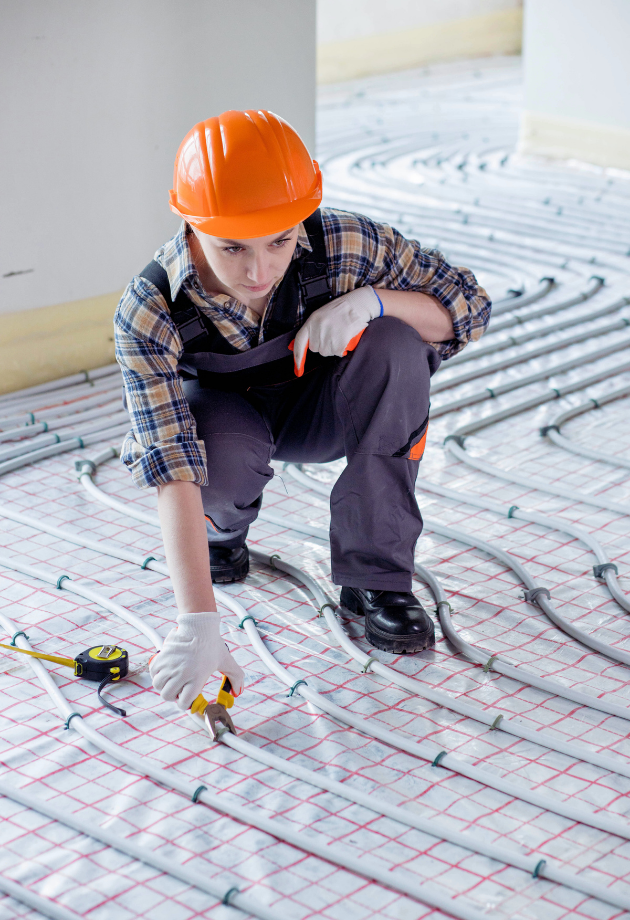Is Radiant Floor Heating Worth It? Here's What Homeowners Need to Know
Is Radiant Floor Heating Worth It? Here's What Homeowners Need to Know
(1).png)
There’s nothing quite like the quiet luxury of stepping onto a warm floor on a chilly morning. No vents hissing to life. No forced air drying out the room. Just radiant, even warmth rising from the floor, wrapping the space in elegant comfort.
Radiant floor heating has become a favorite among homeowners looking to combine modern comfort with clean design. It’s more than a luxury touch; it’s a smart, efficient feature that works beautifully in homes where comfort and design both matter.
In this blog, we’ll walk you through how radiant heat works, why homeowners are drawn to it, where it makes the most sense, and how A Step Above Flooring can help you choose materials that look beautiful and perform beautifully, too.
What Is Radiant Floor Heating and How Does It Work?
Radiant heating works by distributing warmth from the ground up, rather than pushing hot air through vents. It’s a system installed beneath the surface of your flooring, allowing heat to rise naturally into your space. That means no baseboards, ducts, or visible components disrupting your design.
There are two main types: hydronic and electric. Hydronic systems circulate warm water through tubes beneath the floor. Electric systems use heating cables or mats. Both can deliver the same effect: consistent, comfortable warmth across the entire room.
While we don’t install heating systems directly, we do help homeowners determine which types of flooring are compatible with radiant heat and guide them through the selection and installation process with care.
.png)
The Two Types of Radiant Heat (and When They Make Sense)
Hydronic radiant systems are typically best for large spaces or whole-home projects. They connect to a boiler and work well when heating multiple rooms, offering long-term cost efficiency in exchange for a more involved installation. Hydronic systems pair well with materials like ceramic tile and engineered hardwood, which conduct and retain heat effectively across larger areas.
Electric systems, on the other hand, are often the go-to system for remodels, additions, and targeted upgrades, especially in spaces like bathrooms, kitchens, or finished basements. They’re typically easier to install during a flooring update and work well with options such as luxury vinyl plank (LVP) or tile, which are often used in these types of rooms anyway.
Clean Lines, Warm Floors, and No Vents in Sight
One of the biggest draws of radiant heating is what you don’t see. No vents interrupting your walls. No clunky baseboards. No uneven bursts of hot air.
Radiant heated floors create a sleek, uncluttered atmosphere that fits seamlessly into open-concept homes and streamlined interiors. The heat itself moves evenly through the space, helping eliminate the sharp contrasts of warm ceilings and cold toes that forced-air systems often create. Without blowing dust or drying out the air, radiant heat offers quiet comfort with an aesthetic bonus.
Say Goodbye to Cold Spots and Drafty Corners
Because in-floor heat rises from the surface upward, the warmth is consistent—no more hovering over heating vents or layering rugs to stay comfortable. The entire floor becomes an evenly heated surface, helping keep every corner of the room at a comfortable temperature.
How Radiant Heating Helps You Save Without Sacrificing Style
Is radiant heat efficient? Yes. In fact, radiant heating is up to 25% more efficient than forced-air systems. That’s partly because there’s no heat loss through ducts or vents. When heat rises directly through the floor, it doesn’t drift away before reaching you.
Many homeowners find they can lower the thermostat a degree or two while still feeling perfectly cozy. Lowering the thermostat by just one degree can save around 5% on heating costs. Over the course of a typical heating season, that steady adjustment can lead to total savings of 25–30%.
It’s a rare case where style and energy savings go hand in hand.

Where Radiant Heating Makes the Most Sense
Radiant floor systems can be used in any room, but some spaces naturally shine with this kind of upgrade.
- Bathrooms become spa-like retreats with warm tiles underfoot.
- Basements benefit from the even heat distribution that tackles chill-prone concrete floors.
- New builds and full-home remodels allow radiant heating to be integrated from the ground up.
And when a space is already being refloored, it’s the perfect opportunity to explore adding radiant heat—no extra demo required.
A Closer Look at Value, Not Just Price
So, are heated floors worth it? For many homeowners, yes, and not just because they feel good underfoot.
The typical cost of a floor heating system ranges from $1,700 to $6,170, with a national average around $3,831. Electric systems in small spaces often fall on the lower end. Hydronic systems for full homes may land higher.
But unlike many heating upgrades, radiant systems can enhance both comfort and property value. In real estate listings, radiant heated floors are frequently highlighted as premium features. Radiant heating adds real value over time, both in lower costs and in how comfortable your home feels.
The Flooring That Works Best with Radiant Heat
Not all flooring materials are created equal when it comes to conducting heat. If you're investing in radiant floor heating, you'll want to pair it with materials that hold and transfer warmth effectively.
Tile is one of the best conductors, making it an ideal match for radiant systems, especially in spaces like bathrooms and kitchens. Engineered hardwood also performs well, offering the warmth and character of wood with greater dimensional stability. Certain styles of luxury vinyl can be compatible, too, as long as they're rated for radiant heat.
For a closer look at which materials perform best, you can refer to our full blog on which floors can handle the heat.

When Heated Floors Go Wrong, This Is Usually Why
There’s one thing that can undo even the best heating system: a poor installation. A misplaced nail, a damaged wire, or incompatible materials can lead to uneven heating or even system failure.
That’s why it’s important to work with a partner who understands how radiant systems interact with flooring. We install flooring that’s built for performance with radiant heat and make sure everything is done correctly, without compromising the system beneath.
Let A Step Above Flooring Help You Heat Your Home Beautifully
A well-designed floor heating system doesn’t just add comfort; it enhances the flow, function, and feel of your home. When you partner with A Step Above Flooring, we’ll help you select the radiant-compatible materials that make your space both stylish and cozy.
Contact us today to explore radiant-ready flooring options and design solutions that meet your needs beautifully.
